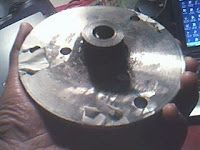 I can’t write a line today without saying that every hobbyist deserves a dedicated workspace/place. I once had a study but as soon as the baby came after marriage, Titi turned it to the baby room. I have been running my projects from a desk in our bedroom. This has always been a subject of concern to Titi. My projects lay in the balcony, the guest bedroom, the walkway the guest bedroom and sometimes our bedroom.
I can’t write a line today without saying that every hobbyist deserves a dedicated workspace/place. I once had a study but as soon as the baby came after marriage, Titi turned it to the baby room. I have been running my projects from a desk in our bedroom. This has always been a subject of concern to Titi. My projects lay in the balcony, the guest bedroom, the walkway the guest bedroom and sometimes our bedroom.With Titi away on a one week break to United States, I moved into the room permanently. I must confess it was a sorry sight by the time she returned to find that the door of her wardrobe was a prop for my make-shift spray booth. That the entire floor was littered with metal fillings from drilling multiple holes in the rotor hub. Half the space on the king-size bed was covered with tools, and other equipment. I moved the jig from the balcony to the bedroom.
To cut a long story short – the pressure was on to hook up the turbine and hoist it on the roof, while I start the second phase and test the turbine.




Putting it on the roof was exciting…. I couldn’t help but wonder if it would spin or not. Though I could feel the cool breeze, I knew it was not as fast or focused like the electric fan I used to test the turbine in the house.  I ran the line down to my flat 2 floors down allowing enough slack to ensure I can cut (if the wire twist around its axis) the wire to fix a plug to routinely unwind the twist.
I ran the line down to my flat 2 floors down allowing enough slack to ensure I can cut (if the wire twist around its axis) the wire to fix a plug to routinely unwind the twist.
 I ran the line down to my flat 2 floors down allowing enough slack to ensure I can cut (if the wire twist around its axis) the wire to fix a plug to routinely unwind the twist.
I ran the line down to my flat 2 floors down allowing enough slack to ensure I can cut (if the wire twist around its axis) the wire to fix a plug to routinely unwind the twist. Just as the final bolts where being tightened, the turbine caught the wind and like they say the rest is history…
I will put up a video of the turbine flying as soon as I can upload one on u-tube. But I was such a pleasure to watch people stare at the alian object on my roof as the walked by. I gave me so much satisfaction to see the smile on their faces - that suggested this house hold has gone "green". Eventhough I was yet to rig it up to the grid, I was humbled that with the help of the internet, I too could cut down on use fossil fuel and save the ozone.
As soon as I finish the volts up option to boost the output current, I can officially say - Phase 2 over!






































